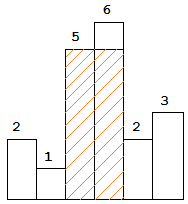-
-
Notifications
You must be signed in to change notification settings - Fork 740
Description
Given n non-negative integers representing the histogram's bar height where the width of each bar is 1, find the area of largest rectangle in the histogram.
Above is a histogram where width of each bar is 1, given height = [2,1,5,6,2,3].
The largest rectangle is shown in the shaded area, which has area = 10 unit.
For example,
Given height = [2,1,5,6,2,3],
return 10.
这道题让求直方图中最大的矩形,刚开始看到求极值问题以为要用DP来做,可是想不出递推式,只得作罢。这道题如果用暴力搜索法估计肯定没法通过OJ,但是我也没想出好的优化方法,在网上搜到了网友水中的鱼的博客,发现他想出了一种很好的优化方法,就是遍历数组,每找到一个局部峰值(只要当前的数字大于后面的一个数字,那么当前数字就看作一个局部峰值,跟前面的数字大小无关),然后向前遍历所有的值,算出共同的矩形面积,每次对比保留最大值。这里再说下为啥要从局部峰值处理,看题目中的例子,局部峰值为 2,6,3,我们只需在这些局部峰值出进行处理,为啥不用在非局部峰值处统计呢,这是因为非局部峰值处的情况,后面的局部峰值都可以包括,比如1和5,由于局部峰值6是高于1和5的,所有1和5能组成的矩形,到6这里都能组成,并且还可以加上6本身的一部分组成更大的矩形,那么就不用费力气去再统计一个1和5处能组成的矩形了。代码如下:
解法一:
// Pruning optimize
class Solution {
public:
int largestRectangleArea(vector<int> &height) {
int res = 0;
for (int i = 0; i < height.size(); ++i) {
if (i + 1 < height.size() && height[i] <= height[i + 1]) {
continue;
}
int minH = height[i];
for (int j = i; j >= 0; --j) {
minH = min(minH, height[j]);
int area = minH * (i - j + 1);
res = max(res, area);
}
}
return res;
}
};
后来又在网上发现一种比较流行的解法,是利用栈来解,可参见网友实验室小纸贴校外版的博客,但是经过仔细研究,其核心思想跟上面那种剪枝的方法有异曲同工之妙,这里维护一个栈,用来保存递增序列,相当于上面那种方法的找局部峰值。我们可以看到,直方图矩形面积要最大的话,需要尽可能的使得连续的矩形多,并且最低一块的高度要高。有点像木桶原理一样,总是最低的那块板子决定桶的装水量。那么既然需要用单调栈来做,首先要考虑到底用递增栈,还是用递减栈来做。我们想啊,递增栈是维护递增的顺序,当遇到小于栈顶元素的数就开始处理,而递减栈正好相反,维护递减的顺序,当遇到大于栈顶元素的数开始处理。那么根据这道题的特点,我们需要按从高板子到低板子的顺序处理,先处理最高的板子,宽度为1,然后再处理旁边矮一些的板子,此时长度为2,因为之前的高板子可组成矮板子的矩形 ,因此我们需要一个递增栈,当遇到大的数字直接进栈,而当遇到小于栈顶元素的数字时,就要取出栈顶元素进行处理了,那取出的顺序就是从高板子到矮板子了,于是乎遇到的较小的数字只是一个触发,表示现在需要开始计算矩形面积了,为了使得最后一块板子也被处理,这里用了个小 trick,在高度数组最后面加上一个0,这样原先的最后一个板子也可以被处理了。由于栈顶元素是矩形的高度,那么关键就是求出来宽度,那么跟之前那道 Trapping Rain Water 一样,单调栈中不能放高度,而是需要放坐标。由于我们先取出栈中最高的板子,那么就可以先算出长度为1的矩形面积了,然后再取下一个板子,此时根据矮板子的高度算长度为2的矩形面积,以此类推,知道数字大于栈顶元素为止,再次进栈,巧妙的一比!关于单调栈问题可以参见博主的一篇总结帖 LeetCode Monotonous Stack Summary 单调栈小结,代码如下:
解法二:
class Solution {
public:
int largestRectangleArea(vector<int> &height) {
int res = 0;
stack<int> st;
height.push_back(0);
for (int i = 0; i < height.size(); ++i) {
if (st.empty() || height[st.top()] < height[i]) {
st.push(i);
} else {
int cur = st.top(); st.pop();
res = max(res, height[cur] * (st.empty() ? i : (i - st.top() - 1)));
--i;
}
}
return res;
}
};
我们可以将上面的方法稍作修改,使其更加简洁一些:
解法三:
class Solution {
public:
int largestRectangleArea(vector<int>& heights) {
int res = 0;
stack<int> st;
heights.push_back(0);
for (int i = 0; i < heights.size(); ++i) {
while (!st.empty() && heights[st.top()] >= heights[i]) {
int cur = st.top(); st.pop();
res = max(res, heights[cur] * (st.empty() ? i : (i - st.top() - 1)));
}
st.push(i);
}
return res;
}
};
类似题目:
参考资料:
https://leetcode.com/problems/largest-rectangle-in-histogram/

